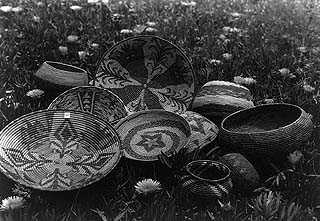World War II & Beyond
Cahuillas served in the armed forces, and worked in war industries during World War II, and thereafter moved
more rapidly into the mainstream of American life than had hitherto been possible. The number living on
reservations, where sanitary facilities and other utilities were very slow to appear, in part because
the U.S. government at the time was bent on termination of the reservations and providing special services
to Native Americans. In the 1960s, the government began again to take an interest in the Indians, and took
steps to bring living conditions more up to date. Natural gas, electricity, water, and telephone service
gradually became more available, and housing was improved as part of the "Great Society" laws of
the Johnson administration. Reservation people began to move back to the reservations, often given
an impetus by the high cost of living in urban areas. As noted in the
"Chemehuevi"
section of this
report, the Twenty-nine Palms Band of Mission Indians is now closely identified with the Cahuillas
of the Coachella Valley, and shares the Cabazon Reservation. The descendants of the Cahuilla who once
lived at Twentynine Palms have scattered, but many of them are enrolled at Morongo Reservation, which
has a successful casino, and is the home of Malki Museum, the first museum in California established
and run by Native Americans.
Introduction
Material Culture, Technology
Trade, Exchange, Storage
Social Structure
Religion
History
Timeline
Traditional Territory
Major Sources

Mission Indians basketry